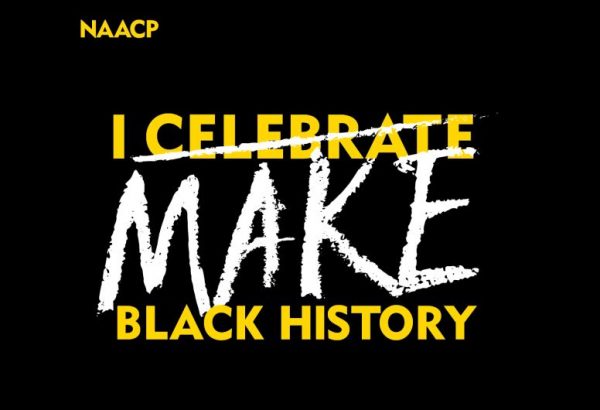Beyond Black History Month: NAACP leaders share why #28DaysAintEnough
Don’t stop your efforts to amplify and support Black employees, community members and more. Here’s how your organization can continue to support racial equality and justice.

Strategies and campaigns are ramping up as spring approaches, but February’s Black History Month is a chapter that is far from closed.
As organizations across industries grapple with how to evaluate and incorporate meaningful DE&I initiatives and support social justice and racial equity, the NAACP is urging brand managers to make the next move:
While highlighting our past achievements and benefactions is vital, charting a course #forward for present and future generations to make history offers a unique opportunity. #28DaysAintEnough
Not when there is so much more history to be made!
Visit https://t.co/gOI710hGe9 pic.twitter.com/pZYKUfL99B
— NAACP (@NAACP) February 1, 2021
#BHM is almost over, but the opportunity to #GetInvolved is endless! Head to https://t.co/ZMfyDnUE7N and see the many ways you can #MakeBlackHistory #AllYearLong because as we know #28DaysAintEnough pic.twitter.com/FwYR10Gfkh
— NAACP (@NAACP) February 25, 2021
A statement on NAACP’s website reads, in part:
While highlighting [Black people’s] past achievements and benefactions is vital, charting a course forward for present and future generations to make history offers a unique and poignant investment.
… Black history is made every day, and we all should remember that year-round.
2020 was a year of awakening for corporations and brands. In the wake of the unconscionable murders of George Floyd, Ahmaud Arbery, and Breonna Taylor, millions took to the streets to say “enough is enough.” Prompted by the undeniable urgency of the moment, foundations, corporations, and brands—large and small—took a stand. Now it’s time to take that one step further.
As connectors and information holders, communicators across departments and roles can be crucial in driving and supporting these efforts, ultimately helping to affect positive change in their organizations, communities and the world.
Consider these takeaways from Vanessa Mbonu, digital director for the NAACP, and Trovon Williams, vice president of marketing and communications for the NAACP:
1. Approach Black History Month as a long-term strategy, instead of a short-term “holiday.”
“Treat Black History Month the same as you would treat any other aspect of American history,” Mbonu says. “We don’t wait until the fourth of July to be patriotic, and so we shouldn’t relegate Black history to just one month. It’s exclusionary by practice.”

Vanessa Mbonu
That’s not to say you shouldn’t participate in and celebrate Black History Month every year, but rather, match your content and messaging with meaningful investments in the Black community. This includes partnering with Black artists and business owners, forging relationships with social justice and racial equity groups, and creating initiatives that can make a difference all year long and far into the future.
Williams says:
This goes beyond charitable donations, but is also deeply rooted in the ability to invest in structural and programmatic initiatives that ensure that the Black community is granted the opportunity to fulfill their creativity and ingenuity of self that ultimately leads to innovations and milestones that not only benefit the Black community, but all communities.
Don’t discontinue content and messaging that highlight and celebrate members of the Black community, Black employees, partners and more once February ends.

Trovon Williams
As you establish meaningful investments and initiatives in the Black community, ensure that your messaging matches your values and vision. Help employees and leaders to consider these values and look for ways to be more inclusive on a regular basis.
Mbonu says:
Don’t archive your Black History Month deck away, just to bring it out again next year. On March 1, keep going. Challenge your teams to stretch the strategy from 28 days to 365 days.
2. Be transparent, consistent and accountable to your DE&I commitments.
These three traits support one another and help you to ensure DE&I initiatives are meaningful and on track. They can also point out shortcomings and show areas that need improvement or efforts that fall short. Start with an honest and transparent look at where your organization stands with DE&I initiatives.
“No DE&I effort is worth its weight in salt if it doesn’t start with an honest report of where the organization currently stands,” says Mbonu.
After assessing your current DE&I efforts, create commitments and plans to meet them that lean on transparency and accountability.
“There should be measurable goals that the organization is aspiring to in terms of showcasing level of progress necessary to show a commitment to diversity and inclusion and social justice,” Williams says.
Regularly and consistently work on these commitments and report your progress. Similar to other communications strategies, if an initiative falls short of your goal, consider why it happened and evaluate how you can adjust to get back on track.
Williams says:
In the same manner that organizations give quarterly reports on financial performances and upcoming product and services initiatives, I believe organizations should look to conduct quarterly reports on their ongoing efforts surrounding building a more diverse and inclusive organizational culture.
“The same, if not more, PR should be put into communicating how much progress has been made, as was put into announcing the commitment to the Black community,” Mbonu says.
Remember, this work is a marathon, not a sprint.
“The reality is, no organization is doing this perfectly,” says Williams. “But the worst thing an organization can do is to pretend that it does not need to be addressed.”
3. Partner to show your support and make a difference.
Mbonu says partnerships are key to successful DE&I and social justice efforts.
Teaming up with an organization that focuses on racial equality and other social justice efforts can also help you to better define your DE&I efforts, nurture your company culture, and provide resources to help you make a difference—all of which can strengthen audience trust and strengthen your brand, Williams says.
For example, NAACP’s Black History Month page lists eight ways that brands can “make a commitment to Black lives in corporate spaces all year long,” including signing the Equal Pay Pledge, joining the One Million Jobs Campaign and more.
Williams says:
Find local partnerships that you can engage with frequently and also choose initiatives that are in alignment with your brand so that you can put your best resources forward in supporting local social justice initiatives. Find a local NAACP branch, volunteer to sign up your organization and its employees as members, and make a concerted effort to participate in local initiatives.
These partnerships are also crucial to helping nonprofits and associations meet their goals and reach additional audiences, opening doors previously closed to organizations such as NAACP.
Meaningful partnerships are key. “Local social justice organizations often have lean staff and even leaner budgets,” Mbonu says. “A partnership with a larger organization that has made a sincere investment in the impacted communities can make all the difference.”
4. Don’t delay starting your organization’s DE&I journey.
“Volunteer, donate, or advocate on behalf of the Black community with the platforms of influence that you have access,” Williams says. “Avoid the urge to avoid, because pretending as if structural issues do not exist will not make them go away.”
If your organization hasn’t done any work in the DE&I space, now is the time to start. If you don’t know how, enlist the help of outside organizations, resources and experts.
Williams says that many of NAACP’s partners have implemented DE&I task forces that are “inclusive of different employees across the organization at different levels.”
He continues:
Their primary goal will be overseeing the progression of the initiatives associated with the organization to ensure its accountability and success. We’ve found this to be a truly impactful start to an organizations DE&I journey.
Regardless of whether you form a formal task force, turn to your BIPOC employees, leaders and other stakeholders to glean valuable insights and direction. Talk with industry colleagues and learn what they’re doing to nurture diverse and inclusive company cultures, take stands on important social issues, and integrate DE&I best practices.
“Start somewhere, anywhere,” says Mbonu. “But just start.”
5. Look for ways to integrate Black history into your regular conversations, content and more.
Viewing Black History Month as a long-term strategy within your communications is important, but it’s only the beginning.
“The reality is the Black history is American history,” says Williams.
“We adjust our strategies each day to reflect what’s happening on the Hill, trends in marketing and advertising, and whatever else the news of the day is,” Mbonu says. “We must do the same for Black history, triumph and achievement because it’s happening every day.”
Organizations that are successfully integrating Black history into their day-to-day efforts are those with clear and measurable DE&I commitments, outstanding workplace cultures that seek to support and amplify all voices, and storytelling efforts and content that unapologetically stand for racial equality and social justice while recognizing members of the Black community.
Just as you carefully consider how your strategies, campaigns and messages will affect your audiences and your brand reputation, think about how each will also affect members of the Black community and make a difference.
“If we orchestrate and work to ensure that we are infusing the contributions of the Black community into the foundation of our organizational structures both in acknowledgement of their contribution and in analysis of how we honor their efforts through ensuring we build a culture conducive for all, we will never need to put Black History down, but we can take it with us every single day,” Williams says.
Don’t consider this integration as a checklist. Instead, strive to build it into your organization’s DNA and the way you work as a communications expert and partner.
“Highlighting Black history shouldn’t be treated as a chore,” Mbonu says. “Your audience will notice when you do so.”
You can learn more from Mbonu at Ragan’s Social Media & Digital Communications Virtual Conference on March 16. She will speak about increasing DE&I and elevating purpose through social media, alongside Kevin Clayton, vice president of inclusion, diversity and community engagement at Cleveland Cavaliers. Register here.
Glean additional insights from Williams at Ragan’s Media Relations & Measurement Virtual Conference on April 7. He will discuss how to focus on purpose, adapt to values-based spending and resonate with multicultural audiences. Register here.







